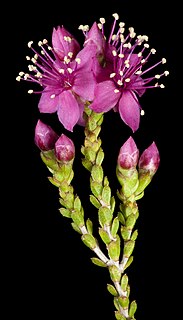
Hakea orthorrhyncha, commonly known as bird beak hakea, is a shrub which is endemic to the Murchison River area of Western Australia.

Homalocalyx is a genus of shrubs in the family Myrtaceae described as a genus in 1857. The entire genus is endemic to Australia.
Persoonia spathulata is a species of flowering plant in the family Proteaceae and is endemic to the south-west of Western Australia. It is an erect to spreading shrub with hairy young branchlets, spatula-shaped leaves, and yellow flowers arranged singly or in pairs on a rachis up to 2 mm (0.079 in) long that continues to grow after flowering.
Persoonia bowgada is a species of flowering plant in the family Proteaceae and is endemic to the south-west of Western Australia. It is an erect to spreading shrub with smooth bark, more or less cylindrical leaves and yellow flowers in groups of up to ten on the ends of branches.
Homalocalyx aureus is a member of the family Myrtaceae endemic to Western Australia.
Homalocalyx chapmanii is a member of the family Myrtaceae endemic to Western Australia.
Homalocalyx coarctatus is a member of the family Myrtaceae endemic to Western Australia.
Homalocalyx echinulatus is a member of the family Myrtaceae endemic to Western Australia.
Homalocalyx ericaeus is a member of the family Myrtaceae endemic to Western Australia.
Homalocalyx inerrabundus is a member of the family Myrtaceae endemic to Western Australia.
Homalocalyx pulcherrimus is a member of the family Myrtaceae endemic to Western Australia.
Homalocalyx staminosus is a member of the family Myrtaceae endemic to Western Australia.

Homalocalyx thryptomenoides is a member of the family Myrtaceae endemic to Western Australia.
Lophostemon grandiflorus is a member of the family Myrtaceae endemic to Western Australia, the Northern Territory and Queensland.
Conospermum scaposum is a shrub endemic to Western Australia.
Conospermum sigmoideum is a shrub endemic to Western Australia.

Petrophile recurva is a species of flowering plant in the family Proteaceae and is endemic to south-western Western Australia. It is an erect, many-branched shrub with needle-shaped, sharply-pointed leaves, and spherical heads of hairy pale yellow or cream-coloured flowers.
Synaphea constricta is a shrub endemic to Western Australia.
Synaphea interioris is a shrub endemic to Western Australia.

Isopogon scabriusculus is a species of flowering plant in the family Proteaceae and is endemic to southwestern Western Australia. It is a shrub with cylindrical, or narrow flat, sometimes forked leaves, and spherical to oval heads of pink or red flowers.




